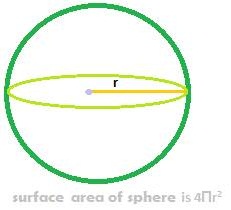Surface area of a sphere.

The total surface area of a sphere or simply the surfacea area of a sphere is 4Πr2
Solved Problems on surface area of a sphere
Example:
The surface area of a sphere is 2464 sq.cm s. Find the radius of the sphere.
Solution:
Surface area of a sphere is 4Πr2
So, 4Πr2 = 2464, i.e.
4 × 22/7 × r2 = 2464, so,
r2 = (2464 × 7)/88 = 196
so, r = √196 = 14
so radius of the sphere is 14 cm's.
Example:
Find the percentage increase in the surface area of a sphere, if the radius of the sphere increases by 50%
Solution:
The surface area of a sphere is 4Πr2
After 50% increase in radius of the sphere, the new radius will become
(150/100)r = 1.5r or 3r/2,
Substituting this in 4Πr2, we get
4Π×(3r/2)2 = 4Π (9r2/4) = (9/4)( 4Πr2)
So, the final surface area of a sphere, after its radius increases by 50%, will become
(9/4)( 4Πr2)
Now, the amount of increase in the surface area of sphere is:
(9/4)( 4Πr2) – (4Πr2) = (5/4)(4Πr2) = 1.25 × 4Πr2
Therefore, percentage increase in surface area of sphere is
![]()
(1.25 × 4Πr2) × 100%/( 4Πr2) =
1.25 × 100% = 125%
So, the surface area of a sphere increases by 125%, if the radius of the sphere increases by 50%


